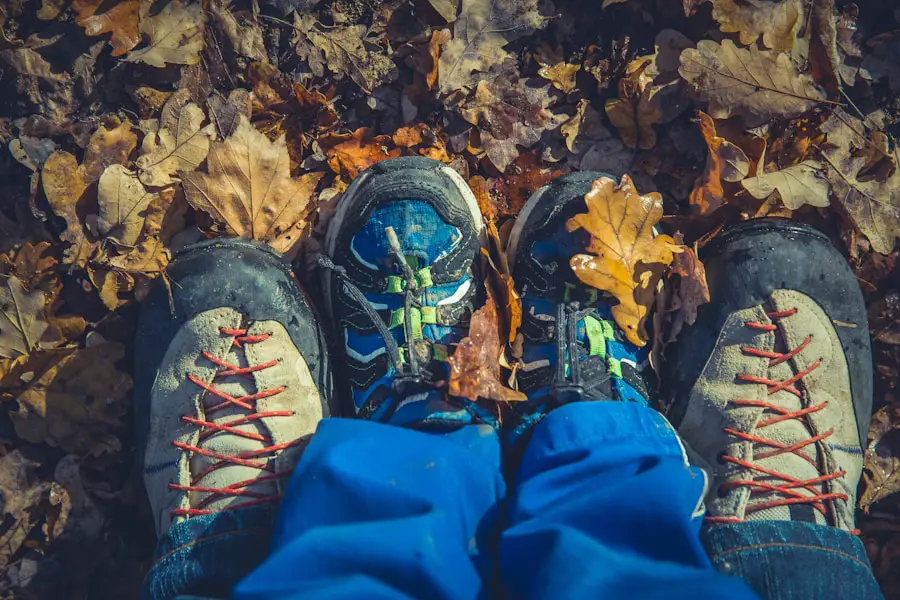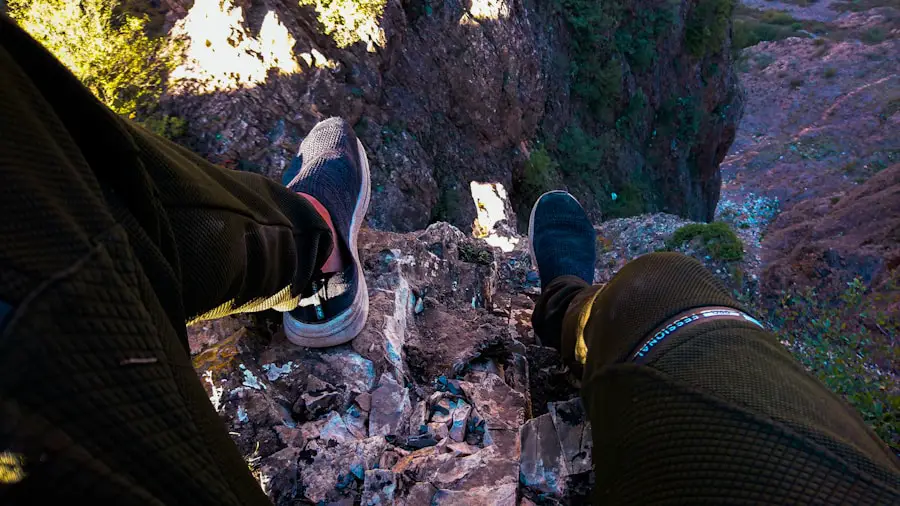The significance of wearing properly fitting hiking shoes cannot be overstated. A well-fitted shoe serves as the foundation for a successful hiking experience, providing the necessary support and comfort to navigate various terrains. When hiking, the feet endure a considerable amount of stress, and ill-fitting shoes can lead to discomfort, pain, and even injuries.
Shoes that are too tight can cause blisters and pinched nerves, while those that are too loose may lead to instability and an increased risk of ankle sprains. Therefore, investing time in finding the right pair of hiking shoes is essential for both novice and seasoned hikers. Moreover, the right hiking shoes can enhance performance by improving traction and stability on uneven surfaces.
Hiking often involves traversing rocky paths, muddy trails, and steep inclines, all of which require footwear that can grip the ground effectively. Shoes designed specifically for hiking typically feature specialized outsoles that provide superior traction, allowing hikers to maintain their footing in challenging conditions. Additionally, a proper fit ensures that the foot is securely held in place, reducing the likelihood of slipping inside the shoe and sustaining injuries.
Ultimately, the right pair of hiking shoes not only contributes to a more enjoyable experience but also plays a crucial role in ensuring safety on the trail.
Key Takeaways
- Properly fitting hiking shoes are crucial for preventing foot pain and injury during hikes.
- Choosing the right hiking socks can help prevent blisters and provide additional comfort and support.
- Gradually increasing hiking distance can help condition your feet and prevent overuse injuries.
- Using blister prevention techniques such as moleskin or blister pads can help protect your feet during long hikes.
- Breaking in hiking shoes with short walks can help mold the shoes to your feet and prevent discomfort during longer hikes.
- Ensuring proper lacing techniques can help prevent foot slippage and hot spots during hikes.
- Utilizing foot care products such as foot powder or anti-chafing balm can help prevent discomfort and blisters.
- Seeking professional advice for foot issues such as pronation or plantar fasciitis can help prevent long-term foot problems.
Choosing the Right Hiking Socks
Selecting the appropriate hiking socks is just as critical as choosing the right shoes. The ideal hiking sock should provide cushioning, moisture-wicking properties, and temperature regulation to keep feet comfortable throughout the hike. Materials such as merino wool or synthetic blends are often recommended because they effectively manage moisture while providing warmth without overheating.
Wool, in particular, has natural antimicrobial properties that help reduce odor, making it a popular choice among hikers who spend extended periods on the trail. In addition to material considerations, the thickness of the sock can also impact comfort and fit. Thicker socks may offer additional cushioning and warmth, which can be beneficial in colder climates or during long hikes.
However, they can also take up more space inside the shoe, potentially leading to a tighter fit that could cause discomfort. Conversely, thinner socks may be more suitable for warmer weather or shorter hikes but might not provide enough cushioning for longer treks. Therefore, it is essential to consider both the climate and the duration of the hike when selecting socks to ensure optimal comfort and performance.
Gradually Increasing Hiking Distance

When embarking on a hiking journey, especially for beginners or those returning after a long hiatus, it is crucial to gradually increase hiking distance. This approach allows the body to adapt to the physical demands of hiking while minimizing the risk of injury. Starting with shorter hikes enables individuals to build endurance and strength over time.
For instance, a novice hiker might begin with a two-mile trek on relatively flat terrain before progressing to more challenging trails that involve elevation changes and longer distances. Incorporating gradual increases in distance not only helps in physical conditioning but also allows hikers to assess their gear and make necessary adjustments. As one becomes accustomed to longer hikes, they may discover that certain equipment—such as shoes or backpacks—needs to be modified or replaced for better performance.
Additionally, this incremental approach fosters confidence in one’s abilities, making it easier to tackle more demanding hikes in the future. By respecting one’s limits and allowing for adequate recovery time between hikes, individuals can enjoy a sustainable and rewarding hiking experience.
Using Blister Prevention Techniques
| Blister Prevention Technique | Effectiveness | Cost |
|---|---|---|
| Properly fitted shoes | 90% | |
| Moisture-wicking socks | 85% | |
| Foot powder or lubricants | 80% | |
| Blister pads or bandages | 95% |
Blisters are a common nuisance for hikers, often resulting from friction between the skin and footwear. To prevent blisters from forming, several techniques can be employed. One effective method is to ensure that both shoes and socks fit properly; as previously mentioned, ill-fitting footwear is a primary culprit in blister formation.
Additionally, applying blister prevention products such as moleskin or blister pads can provide an extra layer of protection on areas prone to friction. Another strategy involves using moisture-wicking socks that help keep feet dry by drawing sweat away from the skin. Keeping feet dry is essential because moisture can exacerbate friction and lead to blister development.
Some hikers also find success with anti-chafing balms or powders that create a protective barrier on the skin. These products can be particularly useful during long hikes where prolonged movement increases the likelihood of friction-related issues. By implementing these blister prevention techniques, hikers can focus on enjoying their journey rather than dealing with painful foot injuries.
Breaking in Hiking Shoes with Short Walks
Breaking in new hiking shoes is an essential step that should not be overlooked. New footwear often requires a period of adjustment for both the shoes and the wearer’s feet. To facilitate this process, it is advisable to start with short walks before embarking on longer hikes.
This gradual introduction allows the shoes to mold to the shape of the feet while enabling hikers to identify any potential discomfort or pressure points early on. During these short walks, it is beneficial to wear the same socks that will be used on longer hikes to ensure an accurate fit assessment. Hikers should pay attention to how their feet feel during these initial outings; any signs of discomfort should be addressed promptly by adjusting lacing techniques or considering different sock options.
If blisters or hotspots develop during these short walks, it may indicate that further adjustments are needed before tackling more challenging trails. By taking the time to break in hiking shoes properly, hikers can significantly reduce the risk of foot-related issues during their adventures.
Ensuring Proper Lacing Techniques

Heel Lock Lacing Technique
This technique involves threading the laces through the top eyelets in a way that secures the heel in place. This can be particularly beneficial for those with narrow heels or those who experience heel slippage during hikes.
Customizing Lacing Tension
Adjusting lacing tension throughout different sections of the shoe can enhance comfort and support. For example, hikers may choose to lace their shoes more loosely around the forefoot for added comfort while keeping them tighter around the midfoot and ankle for stability.
Experimenting with Lacing Patterns
Experimenting with different lacing patterns can help individuals find what works best for their unique foot shape and hiking style. By mastering proper lacing techniques, hikers can ensure their shoes fit securely and comfortably throughout their journey.
Utilizing Foot Care Products
In addition to selecting appropriate footwear and socks, utilizing foot care products can significantly enhance comfort during hikes. Various products are available specifically designed for foot health, including blister prevention tapes, antifungal powders, and moisturizing creams. Blister prevention tapes can be applied to areas prone to friction before heading out on a hike, providing an extra layer of protection against blisters.
Antifungal powders are particularly useful for keeping feet dry and preventing fungal infections that can occur in warm, moist environments. These powders absorb excess moisture and help maintain a healthy environment within shoes. Furthermore, after a long day on the trail, applying moisturizing creams can help soothe tired feet and prevent dryness or cracking.
By incorporating these foot care products into their routine, hikers can enhance their overall comfort and reduce the likelihood of foot-related issues during their outdoor adventures.
Seeking Professional Advice for Foot Issues
For individuals experiencing persistent foot problems or discomfort while hiking, seeking professional advice from a podiatrist or orthopedic specialist is highly recommended. These professionals possess specialized knowledge regarding foot anatomy and biomechanics, allowing them to provide tailored recommendations based on individual needs. They can assess gait patterns, identify any underlying issues such as flat feet or high arches, and suggest appropriate footwear or orthotic solutions.
In some cases, custom orthotics may be prescribed to provide additional support and alleviate discomfort during hikes. These devices are designed specifically for an individual’s foot structure and can significantly improve overall comfort while walking or hiking. Additionally, professionals may offer guidance on exercises or stretches that can strengthen foot muscles and improve flexibility, further enhancing one’s hiking experience.
By consulting with experts in foot health, hikers can address any concerns proactively and enjoy their outdoor pursuits with greater confidence and comfort.
If you’re looking to break in your hiking shoes before embarking on your next adventure, you may want to check out this article on 5 Best Double Travel Strollers for Spring Adventures 2025. This article provides tips and recommendations for breaking in hiking shoes to ensure maximum comfort and performance on the trails. Whether you’re a seasoned hiker or just starting out, proper footwear is essential for a successful outdoor experience.
Love travel? Join Our Facebook Community
FAQs
What are the benefits of breaking in hiking shoes?
Breaking in hiking shoes allows the materials to soften and mold to the shape of your feet, reducing the risk of blisters and discomfort during long hikes. It also helps to test the shoes for any potential issues before hitting the trails.
How long does it take to break in hiking shoes?
The time it takes to break in hiking shoes can vary depending on the individual and the stiffness of the shoes. It can take anywhere from a few hours to a few weeks of regular wear to fully break in hiking shoes.
What are some tips for breaking in hiking shoes?
Some tips for breaking in hiking shoes include wearing them around the house or on short walks before hitting the trails, gradually increasing the duration of wear, and using thick hiking socks to simulate the conditions of actual hiking.
Can I speed up the process of breaking in hiking shoes?
While it’s important to allow enough time for the shoes to mold to your feet naturally, you can speed up the process slightly by flexing the shoes, wearing them with thick socks, and using leather conditioners or shoe stretchers to soften the materials.
What should I do if my hiking shoes still feel uncomfortable after breaking them in?
If your hiking shoes still feel uncomfortable after breaking them in, you may need to consider getting them professionally stretched or seeking advice from a footwear specialist. It’s important to ensure that your hiking shoes fit properly to avoid discomfort and potential foot injuries.
